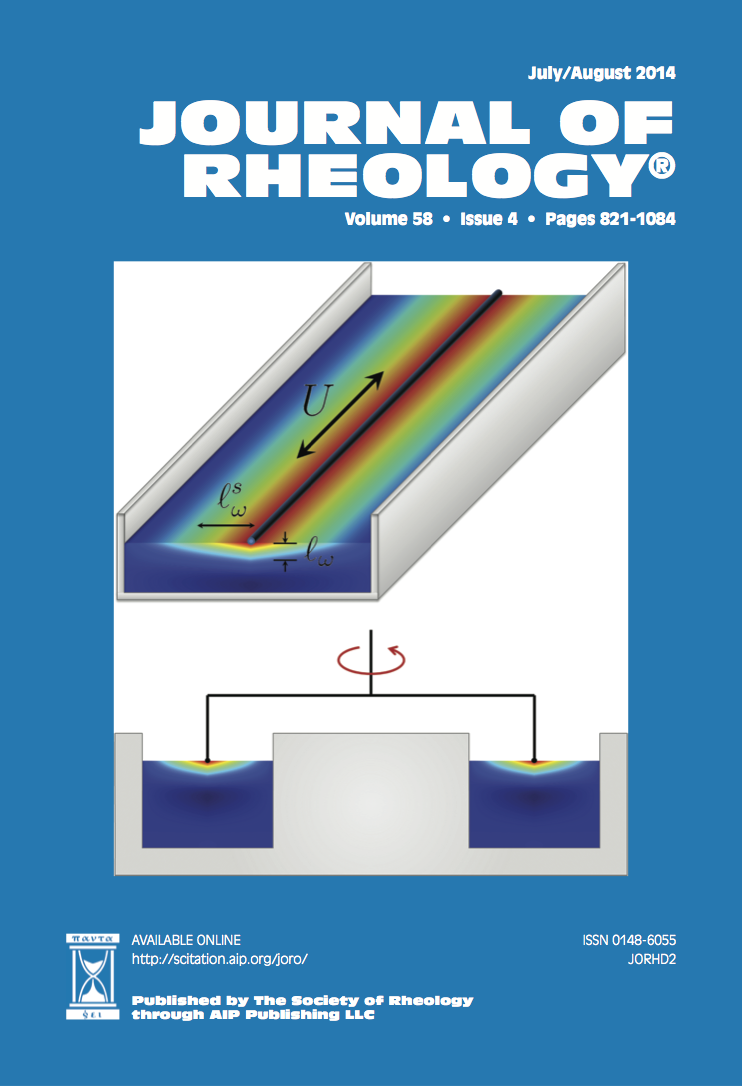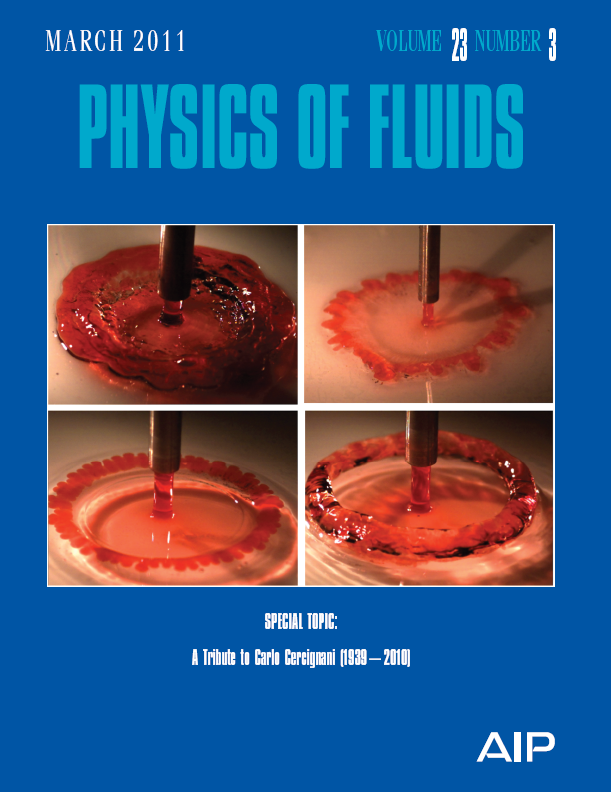Current Projects
Dynamics of Magnetic Microdisks in Rotating Magnetic Fields
M. Tan, H. Song, A. Jander, P. Dhagat, T.W. Walker
In contrast to conventional materials, composites with aligned particles have enhanced mechanical, magnetic, optical, and thermal properties, which can be applied in high-frequency devices, biological tissue scaffolds, and magneto-optics. The anisotropy of the particles allow them to be aligned by applying an external force. With rod-shaped particles, a constant magnetic field can result in a composite material with uniaxial anisotropy. In our study, we have created a planar anisotropy by aligning disk-shaped particles in a rotating magnetic field. To investigate the dynamics of particles in the rotating magnetic field, we have developed a theoretical model, which is based on Stokes flow of a single magnetic oblate ellipsoidal particle in a rotating magnetic field. The model also provides processing conditions that can decrease the alignment time.
Under an external magnetic field, magnetic microdisks will also aggregate, creating chains of particles. We are investigating the chaining dynamics and process conditions that can minimize or slow the chaining. To find the timescale associated with alignment and chaining is crucial for designing the materials.
Song et al. IEEE Trans. Magn. Conf. PP, 99 (2015).
Song et al. IEEE Magn. Lett. 6, 5000304 (2015).
Tan et al. Phys. Fluids. 28, 062004 (2016).
Tan et al. AIChE J. 64, 8 (2018).
Microrheology of Complex Fluids
M. Tan, Y. Mao, T.W. Walker
Nanoparticles and microparticles dispersed in fluids can undergo Brownian motion, which is driven by the thermal energy of the fluids, or active motion, which is driven by an external force. The motion of the particles can be associated with the physical properties of the fluids -- the study of this association is called
microrheology. The motion of the particles can be observed and recorded by a microscope and a camera and then later be analyzed by particle tracking algorithms to extract information about the trajectories. The generalized Stokes-Einstein relation (GSER) can be used to find the storage and loss moduli of complex fluids when the particles are undergoing Brownian motion. Beside the thermal-driven motion, we have built magnetic tweezers to actively move magnetic particles. The creep compliance of the complex fluids can be studied by applying an impulse force, and the frequency-associated storage and loss moduli can be studied by applying an oscillatory force. Microrheologic studies are especially important for complex fluids that are heterogeneous such as mucus, as conventional rheology can only give averaged information. For example, the microrheology can give us the information of the “easy” spots of the mucus where particles can travel through it easily, while particles with certain surface chemistry and size can “find” those easy spots. This knowledge is valuable for developing drug-delivery vehicles that can cure diseases such as chronic obstructive pulmonary disease (COPD) and cystic fibrosis (CF).
Extensional Rheology of Weakly Viscoelastic Polymer Solutions
K.A. Marshall, A.M. Liedtke, T.W. Walker
We strive to develop a description of macromolecular dynamics in extensional flow fields for characterization and mod- eling of dilute polymer solutions. The addition of high molecular weight polymer to solvent, even in dilute amounts, can significantly change a fluid’s response to an extensional flow. This behavior is important when formulating models and assessing the ability to print, spray, jet, and spin complex fluids. Generally, macromolecular solutions exhibit large resistance to stretching deformations known as extensional viscosity. For viscous fluids (>20 mPa·s), a capillary breakup extensional rheometer (CaBER) can be used to characterize the extensional relaxation time and transient extensional viscosity of a solution by quantifying the self-thinning of a stretched liquid bridge formed between two parallel plates. Dilute, aqueous solutions, on the other hand, prove challenging to quantify since the time scale of pinch-off is too short for commercial devices, such as the CaBER, to measure. We are exploring a number of novel techniques, as well as evaluating several previous ideas, to provide a detailed description of low-viscosity elasticity.
Marshall, et al. Exp. Fluids. 58, 6 (2017).
Marshall, Walker. Rheol. Acta 58, 9 (2019).
Pseudomonas aeruginosa Biofilm Rheology
U. Daalkhaijav, T.W. Walker
Bacterial biofilms are one of the most intractable problems facing industries ranging from petroleum to the healthcare industry. This matrix of EPS (extracellular polymer substances) provides a diffusion barrier against antimicrobial agents and provides a protective microenvironment where bacterial cultures can thrive.
Pseudomonas aeruginosa is an environmental bacteria that is known for its ability to produce alginate incased biofilm. It can cause major problems in the medical field as an opportunistic pathogen causing recurrent infections in cystic fibrosis (CF) patients and acute infections in burn victims.
P. aeruginosa is known to be virulent against other pathogens, and in CF patients experiencing respiratory distress, it is usually the dominant strain. The rheology of a
P. aeruginosa biofilm can reveal the mechanical properties that give this biofilm its characteristic resistance to environmental stresses such as antibiotics. We find that
P. aeruginosa (PAO1) biofilm is viscoelastic, showing predominantly gel-like behavior, which is likely responsible for
P. aeruginosa biofilm robustness in the presence of outside stresses such as pH, temperature, DO (dissolved oxygen), and antibiotics. We are interested in characterizing the rheology of clinically relevant strains of
P. aeruginosa biofilm and expand to other clinically or industrially relevant biofilm cultures.
Daalkhaijav, Walker. Appl. Rheol. 27, 64033 (2017).
Daalkhaijav, Dunham, Walker. in Pseudomonas aeruginosa -- An Armory Within. (2019).
Role of Platelets Activation in Colon Cancer Metastasis under Coagulation and Shear
J.L. Sylman, Y. Mao, M. Tan, U. Daalkhaijav, T.W. Walker, P. Dhagat, A. Jander, O.J.T. McCarty
Cancer metastasis is the process whereby cancer cells separate from the primary tumor mass, enter the vascular or lymphatic circulation, exit into a new tissue, and colonize the invaded microenvironment. Although significant progress has been made in deciphering the molecular and genetic features of epithelial cancers, much is still unknown about the behavior and effects of cancer cells in the fluid phase during transit through the circulatory system. Several lines of experimental evidence suggest that the activation of blood platelets and the coagulation system play a crucial role in the metastatic progression of cancer. While some studies have provided insights into the mechanism of platelet-tumor cells interactions under shear flow, they have been largely performed in purified or plasma systems or using anticoagulated blood. As a consequence, the role of platelet activation in regulating platelet-tumor cell interactions in the presence of physiologically-relevant conditions of coagulation and shear remains poorly understood. Dr. Owen McCarty’s group at OHSU has developed an innovative quantitative platform to study cell-cell interactions and fibrin formation under shear. In collaboration with our group, they have recently used this approach to demonstrate the role of coagulation in promoting the recruitment of colon cancer cells to thrombus under shear. Concurrently, we have built a “magnetic tweezers” instrument to probe the transient rheological properties of transparent complex fluids. Together, we are performing a feasibility study on an innovative quantitative platform to study cell-cell interactions and fibrin formation under shear in whole blood. By using active bead microrheology (magnetic tweezers), we have shown that the transient rheological changes in the coagulation cascade of patients with varying coagulation can be characterized when the clotting material is transparent (i.e., plasma). To extend this effort to whole blood, we are teaming with Drs. Pallavi Dhagat and Albrecht Jander at OSU with funding from the OHSU Knight Cancer Institute to develop the instrumentation design necessary to track the microparticles in real time in an opaque environment. Such capability for magnetic particle imaging would allow real-time transient rheology of the coagulation event to be measured in whole blood with minimal external influences, enabling circulation of cancer cells to be understood in physiologically relevant conditions.
Sylman, et al. Ann. Biomed. Eng. 1 (2016).
Development of an in vitro, biomimetic endothelialization model to study tissue-engineered vascular graft healing
L.A.E. Brunmaier, T.M. Brenza, T.W. Walker
Angiogenesis is a biological process of sprouting and growing new blood vessels. It is essential in wound healing and tumor growth. Currently, in vitro models of angiogenesis entail cells that are encapsulated and embedded in a 3D hydrogel or grown around cytodex beads. Both models are limited in their ability to mimic the complex in vivo environment. Our research objective is to develop a biomimetic, in vitro, endothelialization model that includes both chemical and physical stimuli that are used to induce human umbilical vein endothelial cells (HUVECs) to sprout from a parent vessel and migrate toward an uncultured channel. With our device, we can collect qualitative data via fluorescent microscopy to capture the entire progression of angiogenesis over a week or longer, while maintaining proper growing conditions for cells. Comparatively, we can collect quantitative data through active microrheology to measure the dynamics of gel stiffness as angiogenesis progresses. Upon anastomosis and lumenization this construct becomes a dynamic model for drug testing, tissue vascularization, and stress testing of endothelial cells.
Rheological Characterization of Cervical Mucus during the Ovulation Cycle
L.L. Han, T.W. Walker
According to the United Nations Foundation, complications during pregnancy and childbirth are the leading cause of death in women that are in their reproductive years, while estimating that a minimum of 250,000 maternal deaths could be prevented by improving access to family planning and maternal health services. In collaboration with Leo Han, M.D., at OHSU, our group’s overall research goal is to identify and develop innovative solutions to evaluate a woman’s reproductive health by measuring the properties of their cervical mucus (CM). CM is produced by the secretory cells of the endocervix and can vary at different stages of the estrous cycle as hormones are released. The current WHO procedure for evaluating CM requires expensive resources, such as a microscope, and can be time consuming and difficult to interpret. Our current goal is to develop an inexpensive and simple-to-use method that would allow women, or a doctor in the field, to track changes in CM. Our hope is to build a tool that would not only allow women to assess their own reproductive health but would also raise women’s reproductive health awareness and promote better family planning. Direct beneficiaries of the proposed innovation include women and health care providers, specifically doctors working in rural areas. Outcomes of the proposed innovation include the ability for women to assess their own reproductive health when they do not have access to a medical professional, and the ability for doctors to provide more extensive reproductive care in the field. Indirect beneficiaries include all members of the community that place value in the well-being of their women and children. Thus, the innovation has the potential to generate significant social impacts per dollar invested, not only by improving the health of a specific target group but also by impacting the lives of millions of others via improved family planning and reproductive care.
3D Printing the Future
W.E. Rochefort, T.W. Walker
3D Printing
Harris et al. Front. Mech. Eng. 5, 1 (2019).

